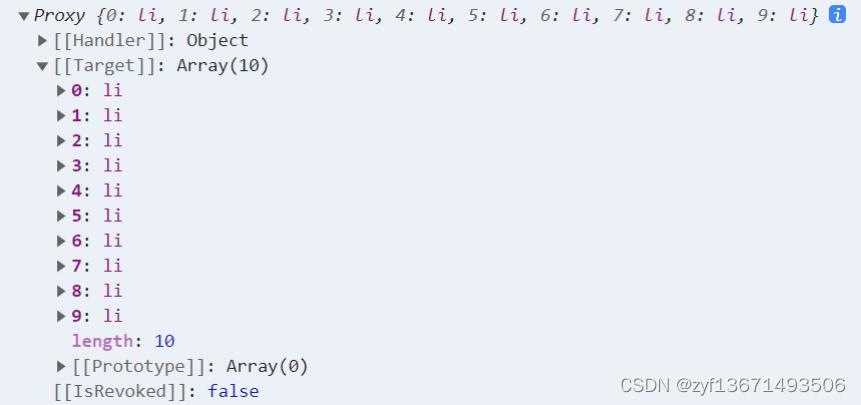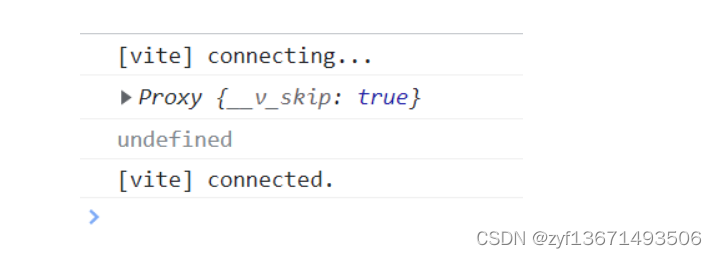Vue3中如何使用ref获取元素节点全面解析
Vue2 中的 ref
<template>
<div id="app">
<div ref="hello">小猪课堂</div>
</div>
</template>
<script>
export default {
mounted() {
console.log(this.$refs.hello); // <div>小猪课堂</div>
},
};
</script>- 1
- 2
- 3
- 4
- 5
- 6
- 7
- 8
- 9
- 10
- 11
- 12
Vue3 中 ref 访问元素
<template>
<div ref="hello">小猪课堂</div>
</template>
<script setup lang="ts">
import { onMounted, ref } from "vue";
const hello = ref<any>(null);
onMounted(() => {
console.log(hello.value); // <div>小猪课堂</div>
});
</script>- 1
- 2
- 3
- 4
- 5
- 6
- 7
- 8
- 9
- 10
运行结果:

注意点:
1.变量名称必须要与 ref 命名的属性名称一致。
2.通过 hello.value 的形式获取 DOM 元素。
3.必须要在 DOM 渲染完成后才可以获取 hello.value,否则就是 null。
v-for 中使用 ref
<template>
<div ref="hello">小猪课堂</div>
<ul>
<li v-for="item in 10" ref="itemRefs">
{{item}} - 小猪课堂
</li>
</ul>
</template>
<script setup lang="ts">
import { onMounted, ref } from "vue";
const itemRefs = ref<any>([]);
onMounted(() => {
console.log(itemRefs.value);
});
</script>- 1
- 2
- 3
- 4
- 5
- 6
- 7
- 8
- 9
- 10
- 11
- 12
- 13
- 14
- 15
- 16
- 17
运行的结果:
 注意点:我们似乎没办法区分哪个 li 标签哪个 ref,除此之外,我们的 itemRefs 数组不能够保证与原数组顺序相同,即与 list 原数组中的元素一一对应。
注意点:我们似乎没办法区分哪个 li 标签哪个 ref,除此之外,我们的 itemRefs 数组不能够保证与原数组顺序相同,即与 list 原数组中的元素一一对应。
:ref 绑定函数
ref 属性接收的是一个 setHelloRef 函数,该函数会默认接收一个 el 参数,这个参数就是我们需要获取的 div 元素。假如需求中我们采用这种方式的话,那么完全可以把 el 保存到一个变量中去,供后面使用。
<template>
<div :ref="setHelloRef">小猪课堂</div>
</template>
<script setup lang="ts">
import { ComponentPublicInstance, HTMLAttributes } from "vue";
const setHelloRef = (el: HTMLElement | ComponentPublicInstance | HTMLAttributes) => {
console.log(el); // <div>小猪课堂</div>
};
</script>- 1
- 2
- 3
- 4
- 5
- 6
- 7
- 8
- 9
- 10
- 11
v-for的更改后使用:方法1
<template>
<ul>
<li v-for="item in 10" :ref="(el) => setItemRefs(el, item)">
{{ item }} - 小猪课堂
</li>
</ul>
</template>
<script setup lang="ts">
import { ComponentPublicInstance, HTMLAttributes, onMounted } from "vue";
let itemRefs: Array<any> = [];
const setItemRefs = (el: HTMLElement | ComponentPublicInstance | HTMLAttributes, item:number) => {
if(el) {
itemRefs.push({
id: item,
el,
});
}
}
onMounted(() => {
console.log(itemRefs);
});
</script>- 1
- 2
- 3
- 4
- 5
- 6
- 7
- 8
- 9
- 10
- 11
- 12
- 13
- 14
- 15
- 16
- 17
- 18
- 19
- 20
- 21
- 22
运行的结果:

这种形式既让我们的操作性变得更大,还解决了 v-for 循环是 ref 数组与原数组顺序不对应的问题。
v-for的更改后使用:方法2
<template>
<div ref='getDivDom' v-for="item in list" :data-id="item.id"></div>
</template>
<script setup>
import { ref} from 'vue'
const divDomList = ref(new Map());
const getDivDom = el=>{
if(el){
divDomList.set(el.dataset['id'],el)
}
}
// const el =divDomList.get(id) // 根据list数据中的id值 获取对应的dom元素 - 1
- 2
- 3
- 4
- 5
- 6
- 7
- 8
- 9
- 10
- 11
- 12
- 13
- 14
组件上使用 ref
<template>
<child ref="childRef"></child>
</template>
<script setup lang="ts">
import { onMounted, ref } from "vue";
import child from "./child.vue";
const childRef = ref<any>(null);
onMounted(() => {
console.log(childRef.value); // child 组件实例
console.log(childRef.value.message); // undefined
});
</script>- 1
- 2
- 3
- 4
- 5
- 6
- 7
- 8
- 9
- 10
- 11
- 12
<template>
<div>{{ message }}</div>
</template>
<script lang="ts" setup>
import { ref } from "vue";
const message = ref<string>("我是子组件");
const onChange = () => {};
</script>- 1
- 2
- 3
- 4
- 5
- 6
- 7
- 8
运行的结果

childRef.value.message 为 undefined,这也是与 Vue2 的不同之处。在 Vue3 中,使用 ref 获取子组件时,如果想要获取子组件的数据或者方法,子组件可以通过defineExpose 方法暴露数据。
改进组件上使用 ref的写法
修改子组件代码:
<template>
<div>{{ message }}</div>
</template>
<script lang="ts" setup>
import { ref } from "vue";
const message = ref<string>("我是子组件");
const onChange = () => {
console.log("我是子组件方法")
};
defineExpose({
message,
onChange
});
</script>- 1
- 2
- 3
- 4
- 5
- 6
- 7
- 8
- 9
- 10
- 11
- 12
- 13
- 14
- 15
- 16
父组件再次获取:
const childRef = ref<any>(null);
onMounted(() => {
console.log(childRef.value); // child 组件实例
console.log(childRef.value.message); // 我是子组件
childRef.value.onChange(); // 我是子组件方法
});- 1
- 2
- 3
- 4
- 5
- 6
运行的结果:

漫思




